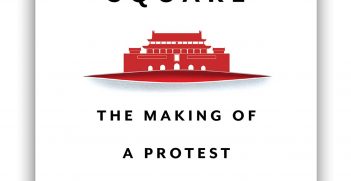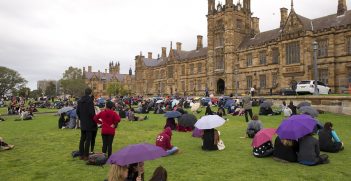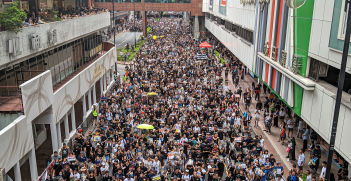India’s Response to the Coronavirus Crisis

As crises go, they rarely come bigger than the Coronavirus pandemic. With India now emerging from the world’s largest lockdown, it appears to have weathered the crisis reasonably well.
There are four fundamental elements to this crisis: (i) it consists of a health crisis and an economic crisis that feed on each other – measures to curtail the health crisis (e.g. lockdown) leads to an economic crisis; the economic crisis in turn reduces resources available for tackling the health crisis; (ii) the crises have evolved over time – health outcomes depend on reducing contact between humans, and the economic crisis results from the sectors of the economy that are affected first and their feedback effects on other sectors of the economy; (iii) consequently there is there is considerable uncertainty in how the twin crises will play out over time; and (iv) well-accepted antidotes are hard to find, and many countries, even those with otherwise robust health systems, have faced critical shortages of essential medical supplies such as testing kits, ventilators, and personal protective equipment (PPE).
Under these circumstances, it is very difficult to know what strategy to follow. There have been some very serious mistakes. For example, Sweden’s chief epidemiologist has publicly stated that not invoking strict lockdown led to too many deaths. Similarly, the UK’s strategy of pursuing herd immunity led to the country having the highest death toll in Europe and a subsequent change in strategy. India’s policy, on the other hand, has been consistent.
The government of India adopted what has been called a modified form of a barbell strategy. The modification here is that the most risky outcomes are insured against and feedback determines the response to the rest. The worst outcomes could have been mass starvation and deaths following from the disruption of supply chains and mass bankruptcy. This modified barbell strategy protected the economy from the worst manifestations of the crises, and yet remained flexible to respond to the evolving circumstances.
Hence, India’s performance in combating the health crisis has been quite good and certainly much better than that of countries (including US, UK, Italy, France and Germany) with far more advanced health systems. India’s recovery rate is steadily rising (currently above 48 percent) and the death rate steadily falling (currently 2.8 percent of all infected cases). 70 percent of India’s COVID-19 cases are in 13 clusters, with the city of Mumbai accounting for 25 percent of all cases. However, the total number of cases is still high (276,146 on 10 June). The director of All India Institute of Medical Sciences, India’s leading hospital, suggests that cases will peak in June-July and then start diminishing. One prediction suggests that the virus will be over in India by mid-September.
India reported its first case of the virus on 30 January – the same day that the WHO declared COVID-19 a public health emergency. Prior to that, India began screening international arrivals from China and Hong Kong as early as January 18 to its three major airports in Delhi, Mumbai and Kolkata. Screening expanded to four more airports from January 21 and a further 13 airports from January 28. From there, testing was rapidly expanded to include more countries and all airports. The WHO declared COVID-19 a pandemic on 11 March, and India imposed a complete lockdown except for essential services on 25 March. This lockdown is still in place, albeit in substantially reduced form. It remains absolute in places like Mumbai and a small number of other containment zones, where the incidence of the disease is high.
A key element of this strategy is that state governments have played a major role in both the imposition and the lifting of lockdown restrictions. The reasoning behind this was the state governments would know local conditions better than the central government, and this method would honour the rights of state governments within India’s federal constitution.
Domestic flights were suspended and have only recently (partially) resumed. Train services for essential commodities such as food, fertilizers, and LPG cylinders have proceeded unimpeded throughout, but passenger services have only recently (partially) resumed. Other forms of public transport including buses are gradually being restored. The lockdown brought most economic and social activity to a halt. But this had a salutary effect on cutting down mortality from COVID-19. It has been estimated that without the lockdown and containment strategies , there would have been more than 820,000 coronavirus cases in India by April 15.
The lockdown has given India’s health system time to strengthen its response. This time was also used to increase India’s production of key medical supplies including testing kits, PPE, and ventilators. This was necessary in light of the uncertainty of these key supplies from China, India’s principal supplier, which was facing the ferocity of the pandemic.
Essential services were maintained. Despite initial fears of mass food shortages as India entered lockdown, there appears to have been no paucity of food in any part of the country. Substantial rations were distributed to people below the poverty line and to farmers, along with free-of-cost delivery of LPG cylinders and cash transfers. To prevent a cascade of default, deadlines for companies to repay loans were pushed back, government-guaranteed loans were meted out to street vendors and the Micro and Small and Medium Enterprises (MSME) sector, the largest employer in India’s formal sector, the definition of the MSME sector was expanded to include larger enterprises, and the deadline for filing of income tax returns was extended.
An important implication of the crisis was that 40 million migrant workers living and working in different parts of the country faced increasing hardship as the lockdown dragged on. The initial advice by the prime minister was for everyone to stay where they were in order to minimise the spread of the virus. Had this advice been followed to the letter, the recent spike in coronavirus cases may not have occurred. However, starting on 28 March, migrant workers understandably grew restive because they had lost their jobs, financial help was tardy, and they wanted to return to their places of origin. This was difficult to organise as permission was needed from state governments for trains to pass through during the pandemic. There was also the risk that transporting such large numbers of people by train or bus could risk an explosion of coronavirus cases. Now, almost all the workers wanting to return have been able to do so on special trains. 3.5 million workers have been returned to Uttar Pradesh alone. 85 percent of the fares for these workers was borne by Indian federal government, and the remaining 15 percent by the states to which these workers were returning. Although passengers were tested before they boarded the trains, there was always the risk that affected workers could spread the virus to their home villages and towns.
An immediate fallout from the reverse migration of workers is that once enterprises start functioning at normal levels, they will face a shortage of workers. This is just one indicator of the breakdown of domestic supply chains during the crisis. International supply chains have been adversely affected, including in critical areas such as medical supplies. A simple reflating of the economy through increased government expenditure would, under these circumstances, lead to high inflation and combined with low growth – stagflation. Hence, getting the supply chain right is essential for attaining high growth with moderate inflation.
On the supply side, despite the lockdown, the rabi (winter) crop was harvested and sold in time. Second, it seems that the rain gods will be kind to India for the kharif (summer) crop. Rainfall is estimated to be above normal in many parts of India. In anticipation of a good harvest, fertiliser sales were 45 percent higher in April and May this year, compared to 2019. The reverse migration of workers to villages will also ensure that there are enough workers during the peak agricultural season. To alleviate pressures on the rural economy, allotments to the National Rural Employment Guarantee program have been sharply increased so that rural infrastructure can be augmented rapidly. However, prospects for the manufacturing and services sectors are not sanguine. The total value of the stimulus package is ₹20 trillion, or approximately 10 percent of GDP. The Reserve Bank of India has stepped in with substantial liquidity support and a cut in the repo rate to 4 percent. With the fiscal deficit of the government at less than 5 percent of GDP and more than US$490 billion in foreign exchange reserves, there is ample room to begin an infrastructure-led stimulus without causing the currency to depreciate unusually if the current measures are not sufficient.
The next component of the recovery strategy is structural reforms. The government has been able to push through several key structural reforms including (i) amending the Essential Commodities Act, which will permit farmers to sell their produce to the highest bidder anywhere in the country instead of being confined to local markets, as designated by the relevant state government; (ii) increasing the FDI limit in the defence sector from 49 percent to 74 percent; (iii) adopting an aggressive manufacturing strategy in various areas and strategising these for increased exports; (iv) amending labour laws to make them more flexible; (v) amending labour laws to facilitate increased labour market participation by women; and (vi) pursuing a strong policy to attract FDI into India. India has acutely felt the sting of disrupted supply chains and has therefore evinced greater interest in pursuing a policy of self-reliance. This does not mean the advent of neo-protectionism but switching to domestic consumption and mending domestic supply chains.
For India, meeting the challenges of COVID-19 has been daunting. But well-designed policies have ensured relatively smooth passage and ensured a much better outcome than would otherwise have been possible.
Professor Raghbendra Jha is Professor of Economics and Executive Director of Australia South Asia Research Centre, Arndt-Corden Department of Economics at the Australian National University.
This article is published under a Creative Commons Licence and may be republished with attribution.





